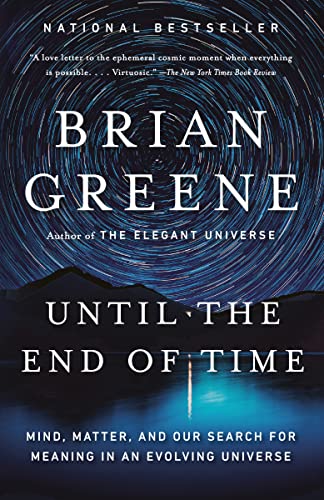What is the multiverse? The idea that the universe we inhabit is just one of many parallel universes gets a superhero shout-out in “Doctor Strange in the Multiverse of Madness,” the latest movie based on Marvel comic-book characters.
And in the opinion of Brian Greene, a theoretical physicist at Columbia University, giving some screen time to the multiverse isn’t such a bad thing — even if the plot has some horror-movie twists.
“I think it’s really good if some of these ideas are brought out in a variety of different ways,” Greene says in the latest episode of the Fiction Science podcast, which focuses on the realm where science and technology intersect with fiction and popular culture.
“Doctor Strange in the Multiverse of Madness” portrays the multiverse as a cross between a funhouse and a haunted house. One scene shows the mage and his protege plunging through a dizzying succession of universes as if they were falling through a kaleidoscope.
The idea of traveling from one parallel universe to another is the one big thing that the movie gets wrong, Greene said.
“That is not something which naturally emerges from the mathematics,” he said. “I should say there are various flavors of multiverse. … In the vast majority of these, it’s not that I could get in a rocket ship and travel out and visit another universe in the multiverse.”

So why do physicists think that other universes exist? Greene said extra dimensions and parallel universes provide ways to make sense out of theories that don’t quite make sense without them. For example, the equations that describe spacetime work most elegantly if they’re expressed in terms of 10 or 11 dimensions, rather than the three spatial dimensions and the one time dimension we perceive.
Dark energy — a diffuse, repulsive force that appears to contribute to the accelerating expansion of our universe — also raises a cosmic conundrum that the multiverse could explain. “When we use the observations to determine how much of this dark energy [is] filling space, the number we get is really odd in the natural units. It’s like a point-zero-zero-zero … 122 zeroes and a one,” Greene said.
Why such an odd non-zero number? “Well, in many of our theories, each of the universes populating a multiverse would have some dark energy, but the amount would vary from universe to universe,” Greene said. “And so if there are enough universes, then one universe among that vast collection will have the amount of dark energy that we observe.”
It’s not inconceivable that some of those universes could be rough approximations of our own, perhaps with a 2 instead of a 1 at the end of that 123-digit string. And in that case, there could be different versions of Brian Greene and Alan Boyle in those universes, chatting about the Earth-838 version of the Doctor Strange movie.
“If my particular collection of particles repeats out there — including the particles making up my brain, making up my memories, making up my thoughts — then that collection of particles somewhere out there in the multiverse will think that it is me, and it really will be me,” Greene said. “When people hear that, they’re like, OK, now we’re in Crazyville.”
Could future discoveries put multiverse theories on firmer footing? One possibility is that studies of the cosmic microwave background radiation — sometimes called the afterglow of the Big Bang — will point to anomalies suggestive of a collision between two universes.
Greene said the Large Hadron Collider, which is gearing up to smash protons together at record energy levels, serves as a “better example” of an experiment that could produce evidence of extra dimensions.
“The idea was, slam proton against proton. From the debris that’s created, the math suggests that some of that debris could drift out of our dimensions and get crushed down into the other dimensions. And if that happened, we would know it because the debris would take away some energy,” he said.
That hasn’t been seen so far — but could something pop up at higher energies? “We don’t know what the data is going to find,” Greene said.

Like Doctor Strange, Greene seems to have a knack for getting caught up in the mysteries of the multiverse. The current focus of his theoretical work has to do with the statistical distribution of different types of possible universes. And he’s also working on a film adaptation of his latest book, “Until the End of Time” (which I wrote about in 2020).
“That book for me is a real synthesis of a whole lifetime of thinking about questions that are scientific, of course, but also go into the questions that we as human beings have asked since we could ask questions,” Greene said. “Like, why are we here? What’s the nature of consciousness, and what actually is religion? … Where’s the universe going as we look from today toward the future, and what does that tell us about the things that matter to us most?”
Delving into such questions just might win Brian Greene the title of Doctor Strange in some corners of the multiverse — and I told him so.
“I’ll take that as a compliment,” he replied with a laugh.
Check out Brian Greene’s website to learn more about his life and work. Greene is co-founder and chairman of the World Science Festival, which has been producing online video presentations on way-out science topics during the coronavirus pandemic and could resume its schedule of in-person events as early as this fall.
Click on over to the original version of this report on Cosmic Log for a 20th-anniversary trivia contest and poster giveaway — and stay tuned for future episodes of the Fiction Science podcast via Anchor, Apple, Google, Overcast, Spotify, Breaker, Pocket Casts, Radio Public and Reason. If you like Fiction Science, please rate the podcast and subscribe to get alerts for future episodes.
Lead image: Doctor Strange is portrayed by Benedict Cumberbatch in “Doctor Strange in the Multiverse of Madness.” Source: Marvel Entertainment.
The post Why Believing in the Multiverse Isn’t Madness appeared first on Universe Today.
No comments:
Post a Comment